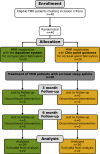Recording the maxillomandibular relationship with the Aqualizer system prior to occlusal splint therapy for treating temporomandibular disorders: a randomized controlled trial
- PMID: 38110552
- PMCID: PMC10728157
- DOI: 10.1038/s41598-023-49911-7
Recording the maxillomandibular relationship with the Aqualizer system prior to occlusal splint therapy for treating temporomandibular disorders: a randomized controlled trial
Abstract
Temporomandibular disorders (TMD) present a public health issue and are one of the most common musculoskeletal conditions causing chronic pain. This study compares the outcomes of occlusal splint therapy in patients with TMD following two different maxillomandibular relationship (MMR) registration techniques. 40 TMD patients were randomly allocated to MMR registration with the Aqualizer system (AQU) or with chin point guidance (CPG) prior to fabricating occlusal splints. TMD symptoms, subjective pain intensity, and quality of life (QoL) were recorded at baseline and after 3 and 6 months. The treatment led to an overall reduction of TMD symptoms in both groups (Conover test, p < 0.00001). TMJ sounds, TMJ pain with palpation and muscle pain with palpation subsided regardless of the type of MMR registration method used (Cohen's d > 0.8). AQU-based occlusal splints led to a better improvement of TMJ pain with maximum opening compared to CPG-based occlusal splints (Cohen's d = 0.9; CPG d = 0.13). In both groups, occlusal splint treatment had little to no effect on correcting lateral mandible deviation or improving restricted jaw opening. After 6 months occlusal splints in both groups had a large effect on improving subjective pain intensity (Cohen's d > 0.8), however, patients reported a higher QoL in the AQU group compared to the CPG group (Mann-Whitney-U-test, p < 0.05). The results of this study support the premise that occlusal splints are effective in relieving pain-related TMD symptoms. The Aqualizer can be considered for determining MMR in cases, where guided registration techniques are not possible.Trial registration: DRKS00031998.
© 2023. The Author(s).
Conflict of interest statement
The authors declare no competing interests.
Figures






Similar articles
-
Comparative evaluation of occlusal splint therapy and muscle energy technique in the management of temporomandibular disorders: A randomized controlled clinical trial.J Indian Prosthodont Soc. 2021 Oct-Dec;21(4):356-365. doi: 10.4103/jips.jips_332_21. J Indian Prosthodont Soc. 2021. PMID: 34810363 Free PMC article. Clinical Trial.
-
The treatment of painful temporomandibular joint clicking with oral splints: a randomized clinical trial.J Am Dent Assoc. 2006 Aug;137(8):1108-14. doi: 10.14219/jada.archive.2006.0349. J Am Dent Assoc. 2006. PMID: 16873326 Clinical Trial.
-
Towards an optimal therapy strategy for myogenous TMD, physiotherapy compared with occlusal splint therapy in an RCT with therapy-and-patient-specific treatment durations.BMC Musculoskelet Disord. 2017 Feb 10;18(1):76. doi: 10.1186/s12891-017-1404-9. BMC Musculoskelet Disord. 2017. PMID: 28183288 Free PMC article. Clinical Trial.
-
Efficacy of occlusal splints in the treatment of temporomandibular disorders: a systematic review of randomized controlled trials.Acta Odontol Scand. 2020 Nov;78(8):580-589. doi: 10.1080/00016357.2020.1759818. Epub 2020 May 18. Acta Odontol Scand. 2020. PMID: 32421379
-
Effectiveness of exercise therapy versus occlusal splint therapy for the treatment of painful temporomandibular disorders: a systematic review and meta-analysis.Ann Palliat Med. 2021 Jun;10(6):6122-6132. doi: 10.21037/apm-21-451. Epub 2021 May 10. Ann Palliat Med. 2021. PMID: 33977737
Cited by
-
The interconnection of oral and systemic health.Sci Rep. 2025 Apr 28;15(1):14931. doi: 10.1038/s41598-025-98718-1. Sci Rep. 2025. PMID: 40295623 Free PMC article.
-
Retention of 3-D-Printed, Milled, and Conventionally Fabricated Occlusal Splints.Med Sci Monit. 2025 Apr 21;31:e947342. doi: 10.12659/MSM.947342. Med Sci Monit. 2025. PMID: 40254853 Free PMC article.
-
Analysis of the Use of Sample Size and Effect Size Calculations in a Temporomandibular Disorders Randomised Controlled Trial-Short Narrative Review.J Pers Med. 2024 Jun 19;14(6):655. doi: 10.3390/jpm14060655. J Pers Med. 2024. PMID: 38929876 Free PMC article. Review.
References
-
- National Institute of Dental and Craniofacial Research: Prevalence of TMJD and its Signs and Symptoms. https://www.nidcr.nih.gov/research/data-statistics/facial-pain/prevalence
-
- Schiffman E, et al. Diagnostic Criteria for Temporomandibular Disorders (DC/TMD) for Clinical and Research Applications: Recommendations of the International RDC/TMD Consortium Network and Orofacial Pain Special Interest Group. J. Oral Facial Pain Headache. 2014;28:6–27. doi: 10.11607/jop.1151. - DOI - PMC - PubMed
Publication types
MeSH terms
Associated data
LinkOut - more resources
Full Text Sources
Medical

